Table of Contents
- Maintaining a Safe Environment
- Leveling and Centering a Tank
- Filling and Draining a Tank
- Establishing Solid Body Rotation
- Reducing Surface Tension
- Visualizing Fluid Motions
- Creating a Cold Source
- Filming an Experiment
- Obtaining Rotating Frame Results
Maintaining a Safe Environment
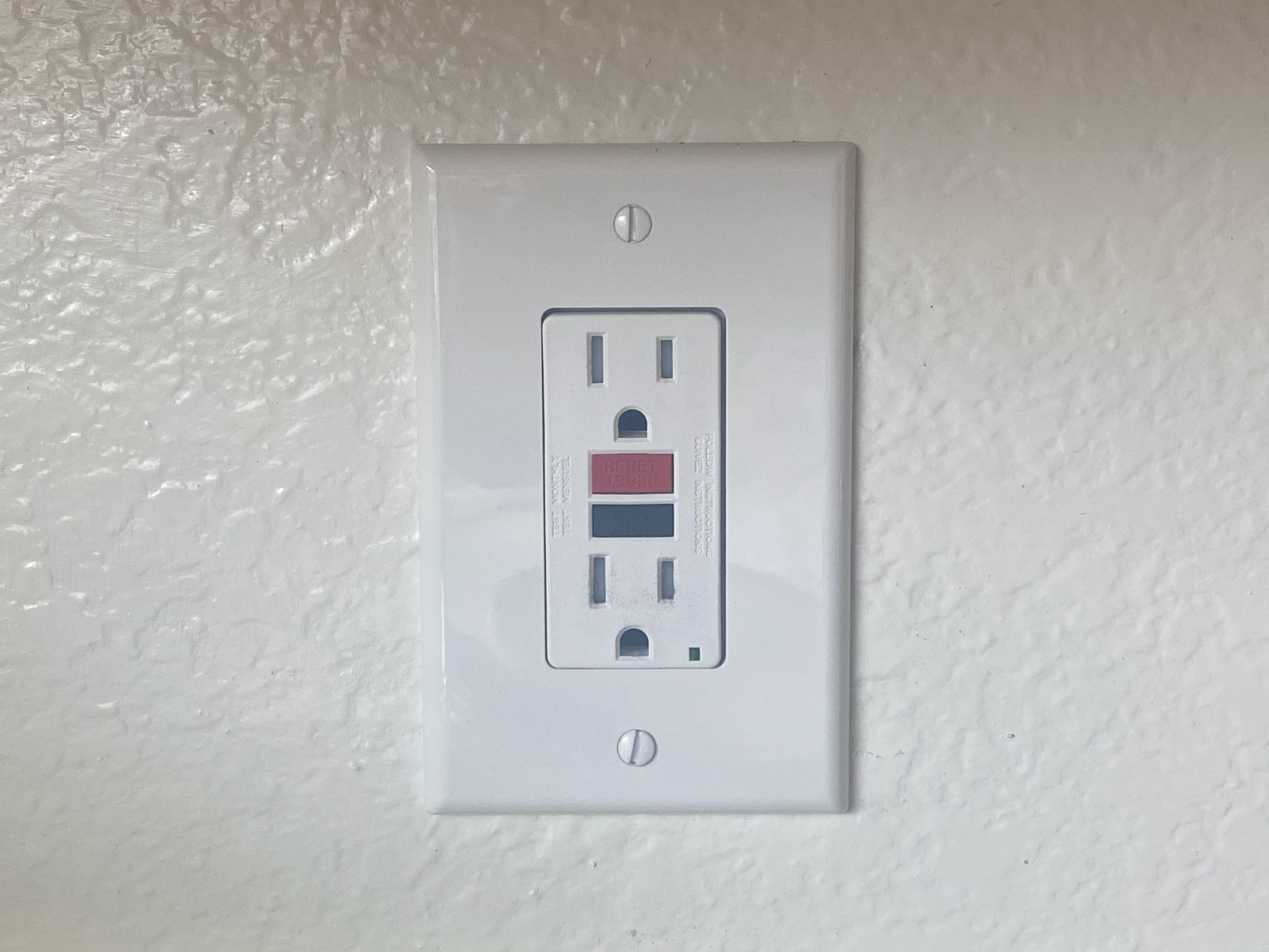
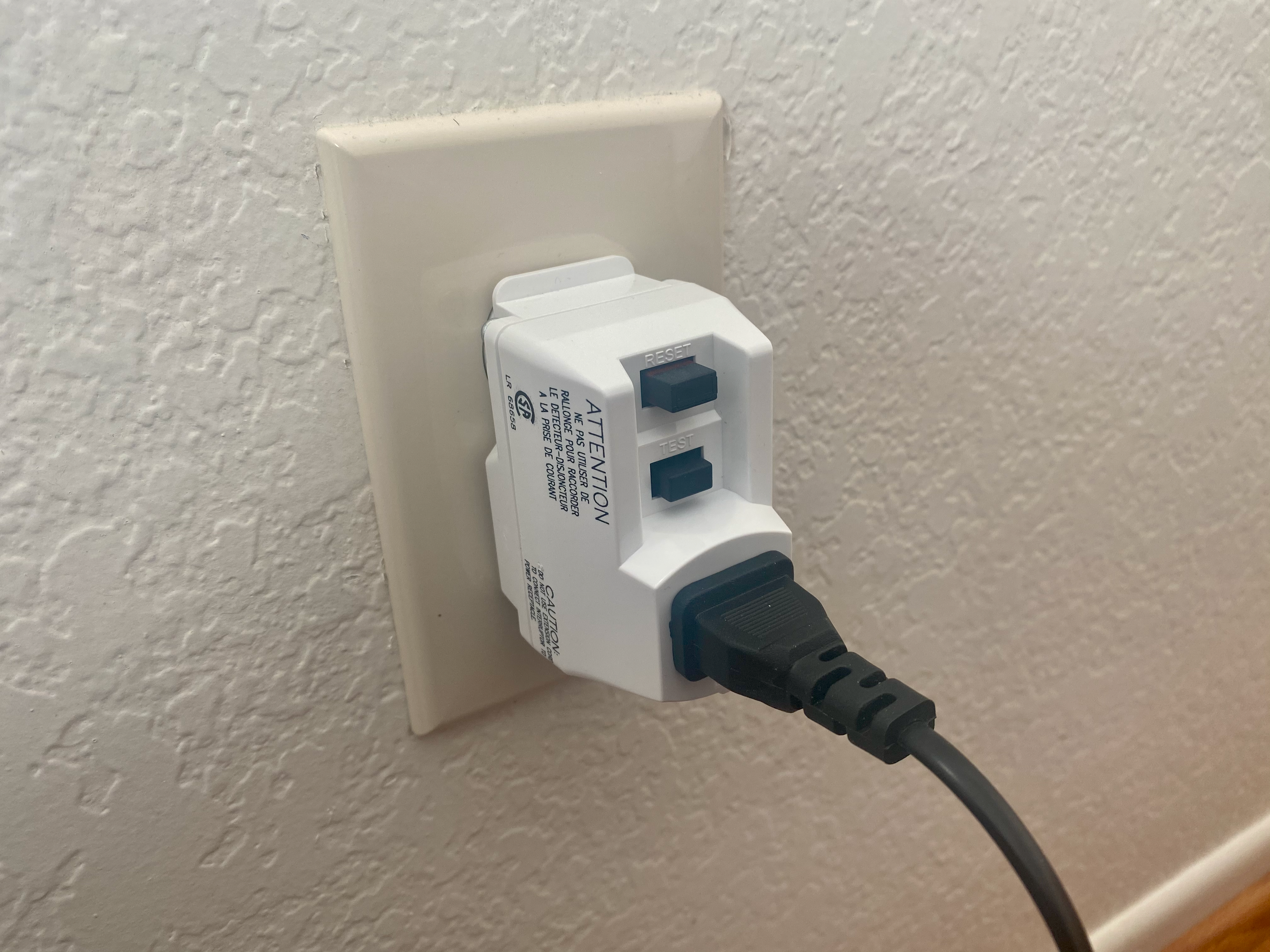
(L) GFCI outlet and (R) GFCI plug. If a GFCI outlet is not available, a GFCI plug can be used in its place.

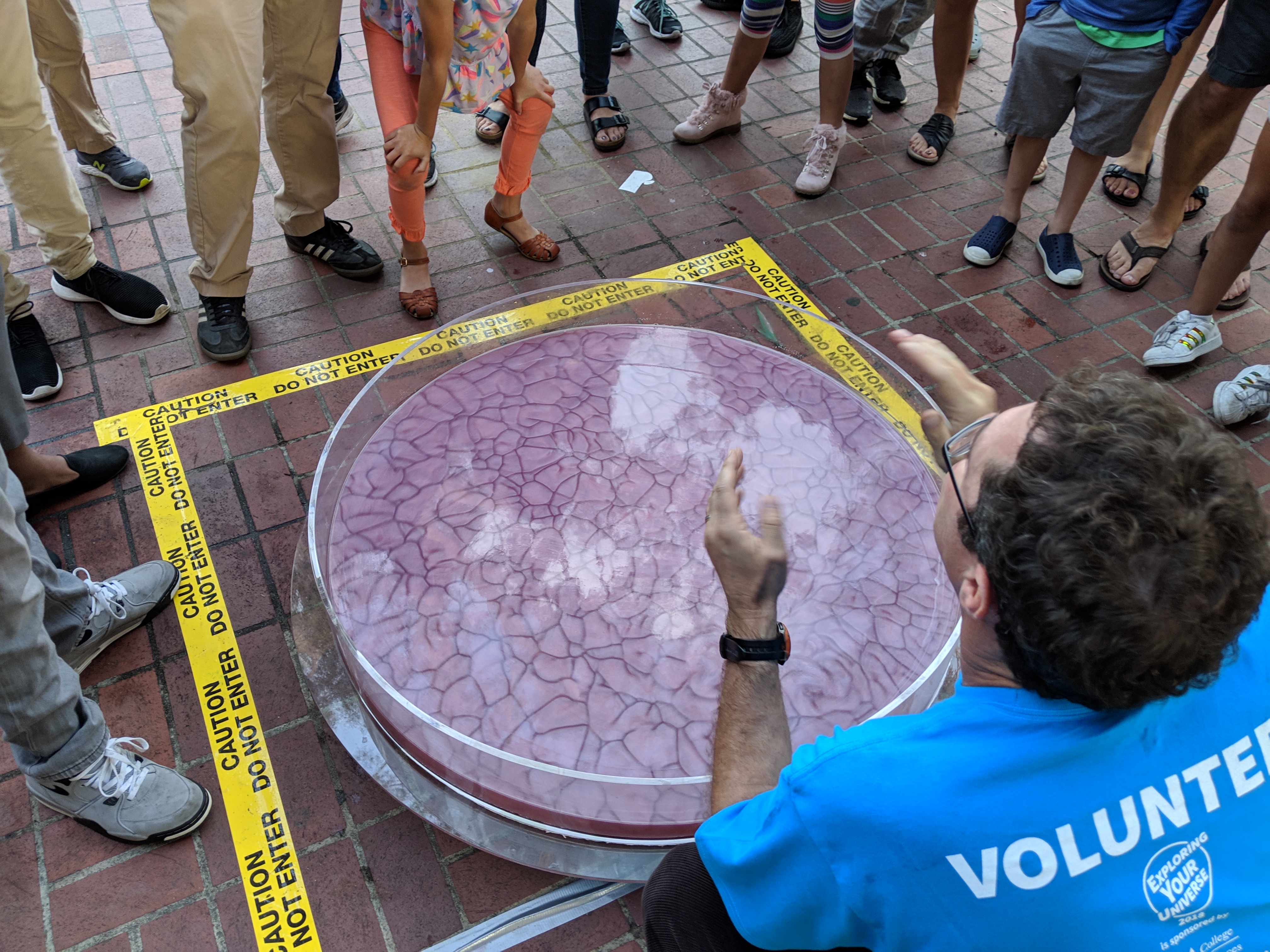
(L) HT3 Table and (R) caution tape. The HT3 Table is designed with a metal frame and is powered by a robust motor. The rotating structure may pose a safety concern for audience members. Caution tape can be used to cordon off the tank.
The DIYnamics Kits provide opportunities for audience members to play an active role in experiments — observing and analyzing results together helps develop an intuition behind the fluid dynamics of planetary systems. The models are well suited for hands-on demonstrations but take the following precautions to ensure that everyone can safely learn.
Disclaimer: Be careful with experiments involving wall power and water in close proximity. The GFCI halts power in the event of a fault and is a vital safety measure in situations involving water and electricity.
Disclaimer: Be careful to stay clear of moving parts. The DJ Table and HT3 Table feature metal frames and robust motors. Caution tape can be used to set boundaries for audience members to safely observe and analyze results whilst out of the path of moving parts.
Recommended Parts - GFCI Plug - Caution Tape
Leveling and Centering a Tank
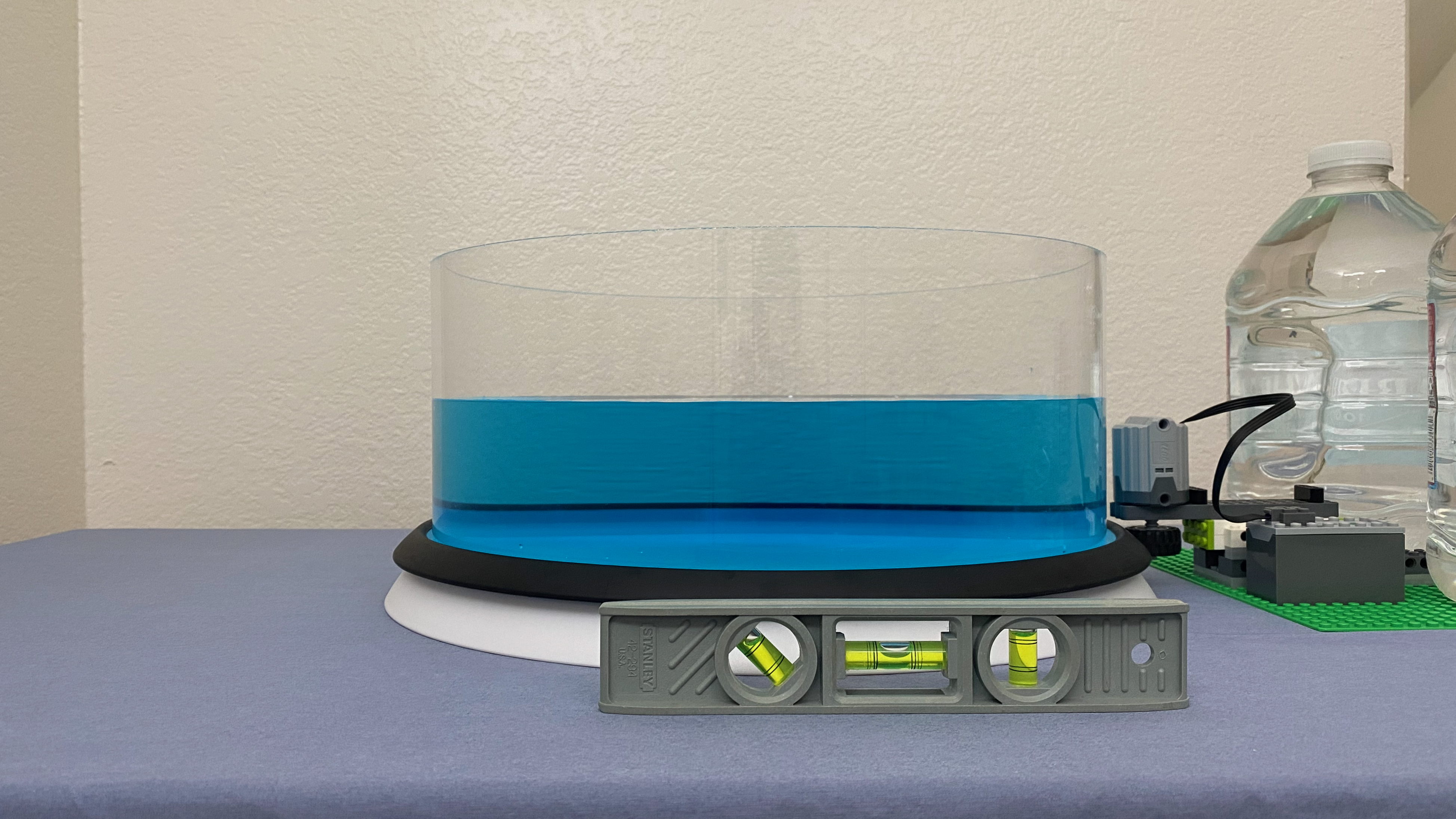
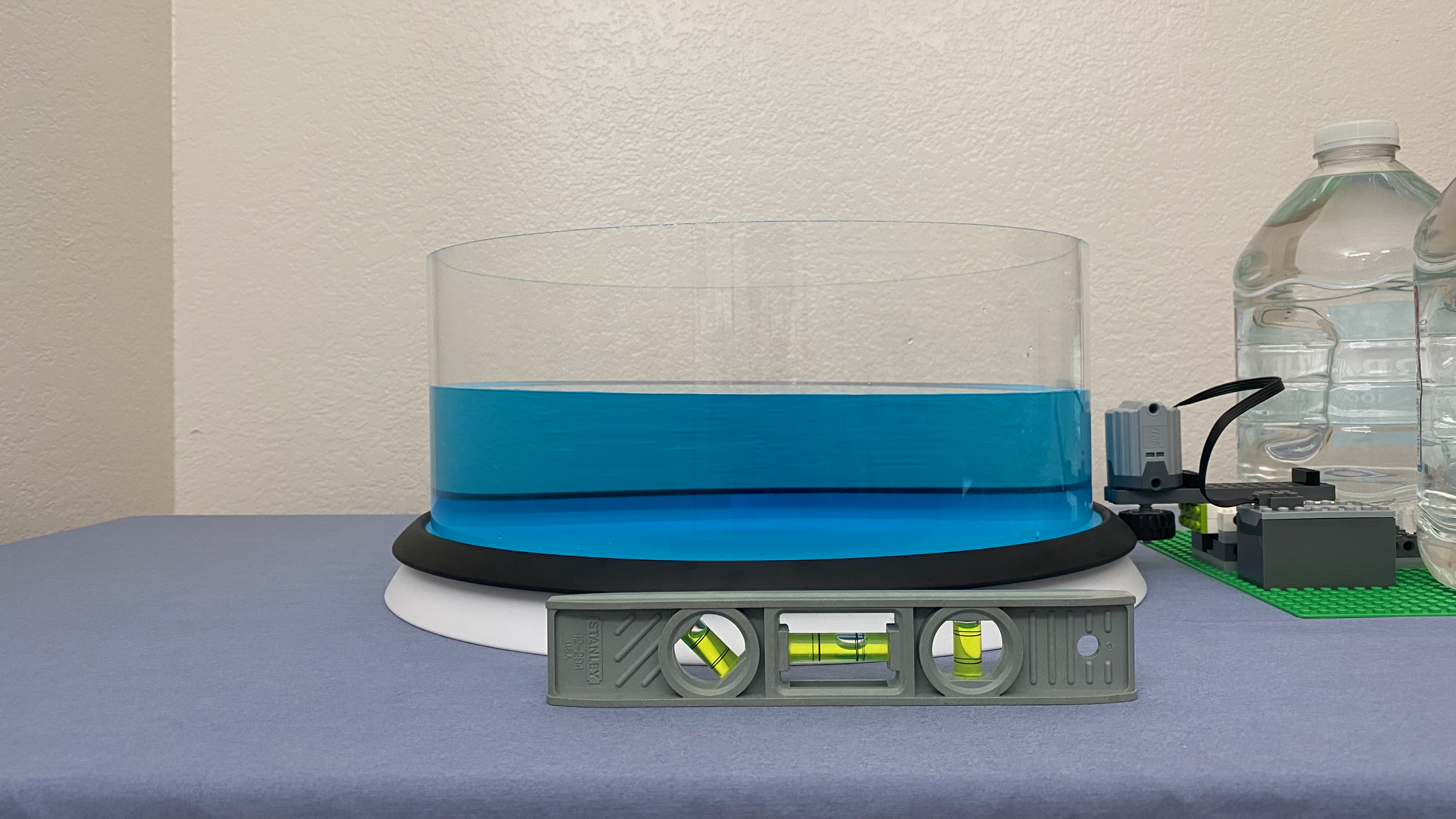
(L) Level versus (R) off-level tank. Notice how the fluid layer is of consistent height throughout the level tank. Meanwhile, the fluid layer varies in height in the off-level tank.

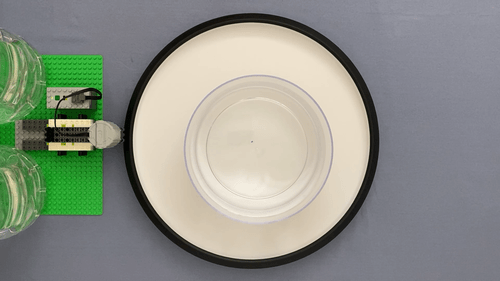
(L) Center versus (R) off-center tank. The center tank appears in the same position throughout the entire rotation cycle. In contrast, the off-center tank appears at different positions during different stages of the rotation cycle.
When performing experiments with the DIYnamics Kits or any other rotating tank platform, the tank must be level and center for optimal results. A tank is level when its bottom is oriented parallel to the horizontal plane. A tank is center when its middlepoint intersects the system’s axis of rotation. Off-level or off-center tanks create unwanted fluid motions such as surface waves that detract from experiments.
A tank can be leveled by iteratively and incrementally using a level to examine a surface’s incline and shims to adjust supports accordingly. The fluid layer of a leveled tank will be of uniform height. A tank can be centered by matching its middlepoint to the system’s axis of rotation and fixing any deviations during rotation. The rim of a centered tank will follow a consistent track throughout an entire rotation cycle.
Recommended Parts - Level - Shims
Guide to Leveling a Tank
Filling and Draining a Tank

The HT3 Table can hold approximately 30 gallons (113 liters) of water when filled to the brim. Be prepared to handle water logistics — filling and draining the tank.
The DIYnamics Kits utilize rotating tanks of water to model the fluid dynamics behind our (and other) planet’s weather, ocean currents and more! Performing experiments necessitates filling and draining water from tanks — be prepared to handle water logistics. To fill a tank, jugs can be used to carry water. To drain a tank, a manual option consists of using cups and a hand operated siphon drum pump to remove water. However, for larger tanks as found in the DJ Table or HT3 Table, using an electric powered utility pump is a convenient and quick automatic option. For both filling and draining a tank, having a water source and sink available nearby is ideal.
Recommended Parts - Jug - Siphon Drum Pump for manual draining - Utility Pump and Hose for automatic draining - Bucket - Sponge - Towel
Guide to Operating a Utility Pump
Establishing Solid Body Rotation

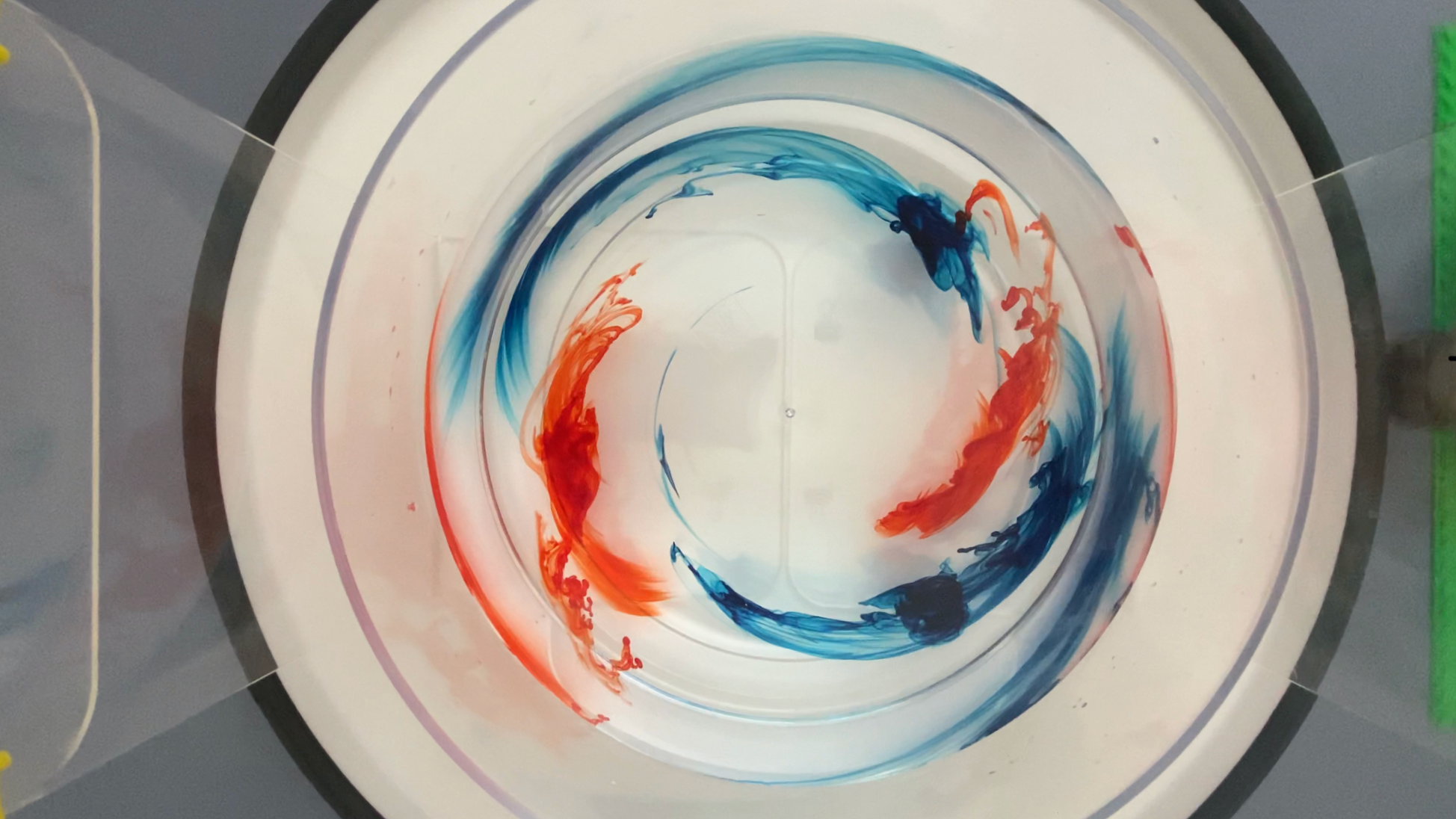
Fluid layer in (L) and not in (R) a state of solid body rotation (colloquially referred to as spun up) or rotating in sync with the system. When spun up, the fluid layer and system feature the same velocity and thus, the dye does not move. Meanwhile, if not spun up, the fluid layer is slower relative to the system and thus, the dye is dragged along.
Rotating tank platforms model the real world by capturing the fundamental impact of a planet’s rotation on its fluid bodies. Specifically, the planet’s rotation establishes a state of solid body rotation in its fluid bodies. Thus, experiments are predicated on the rotating tank platform being similarly spun up.
Solid body rotation refers to a fluid layer rotating at the same velocity as its system. This can include the Earth’s oceans rotating in sync with the planet or a tank of water rotating in sync with its turntable. At rest, the fluid layer and the system feature a velocity of zero. Upon commencing rotation, the system quickly reaches its rate. However, the fluid layer initially does not match the velocity of the system. As the system continues to rotate, the fluid layer is pulled by friction to the same rate starting from the boundaries inwards. Eventually, the fluid layer reaches solid body rotation with the system.
The DIYnamics Kits generally require several minutes to establish a state of solid body rotation — the length of time required increases with size of tank and decreases with rotation rate. You can test whether the fluid layer is spun up by adding a drop of food coloring. If the dye remains in place, the water is in a state of solid body rotation — the fluid layer and the system feature the same velocity resulting in no movement. Meanwhile, if the dye expands contrary to the rotation direction, the water has not reached a state of solid body rotation — the system is faster than the fluid layer resulting in the the prior dragging the latter along.
Reducing Surface Tension


Water with (L) and without (R) surfactant added. Surfactant breaks the water’s surface tension by reducing attraction between its molecules. Notice how food coloring dropped into the water with surfactant remains tight — the food coloring is free to move through the water’s surface. Meanwhile, when food coloring is dropped into the water without surfactant, it disperses — the food coloring encounters resistance at the water’s surface and spreads out before moving through. Note that Ω indicates the rotation direction.
Surface tension refers to the integrity of a liquid’s surface caused by attraction between molecules. The property of liquids results in the liquid’s surface acting as a sheet rather than dissipating. Water is characterized by a high surface tension. As a result, when adding food coloring to water, the water’s surface resists the food coloring.
Surface tension is detrimental to many experiments because the resistance at the liquid’s surface detract from the fluid dynamics of its body — our region of interest. Note that surface tension is an interesting property of liquids to study! Surface tension is key to the natural world (e.g. insects walking on water).
To reduce surface tension, we can add a surfactant or compound that reduces attraction between molecules to the water. Dish soap is an everyday example of a surfactant. Add a drop of dish soap into the water before starting your experiment. This will break the surface tension at the water’s surface thus reducing resistance and allowing us to study the fluid dynamics of its body.
Recommended Parts - Dish Soap
Visualizing Fluid Motions
The DIYnamics Kits model the fluid dynamics of Earth’s (and other planet’s) atmospheres, oceans and interiors. Fluid motions in the tank capture the fundamental behavior of planetary systems. A key step in performing experiments is observing fluid flows to relate structures in the model with the real world. There are multiple solutions for visualizing fluid motions!
Option 1: Food Coloring
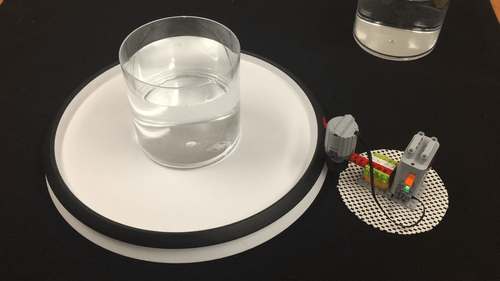
Rotating column experiment with food coloring. Notice how the food coloring tracks each tendril of the fluid flows and provides a 3D view of structures.
Food coloring is the go-to option for visualizing fluid motions. Observing the progression of dye through water provides an intuitive glimpse into fluid flows. Note that marked and unmarked fluid are both subject to the fluid dynamics of the system — the dye merely allows us to track the fluid with our naked eye. A benefit of food coloring is that its semitransparent nature provides a 3D view of structures. Furthermore, using a variety of colors can help illustrate the interaction between different regions of the fluid layer. Tips for working with food coloring includes adding surfactant to the water and avoiding excess — the dye works best when there is contrast. Food coloring is a precise and straightforward solution perfect for the majority of experiments!
Option 2: Barbasoloscope
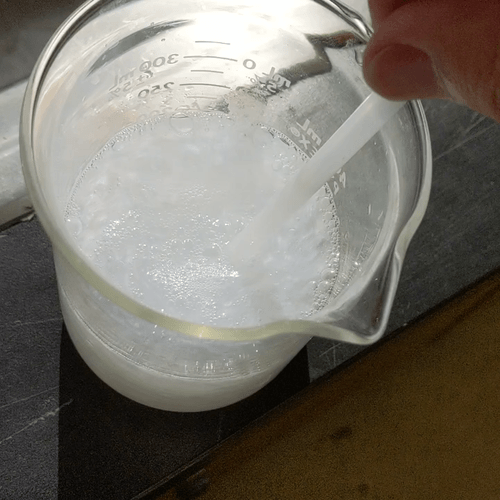

(L) Stirring Barbasoloscope. The rheoscopic fluid is produced by mixing water and shaving cream. Stearic acid crystals in suspension mark fluid flows. Notice the bubbles at the surface — an oily film rises atop the solution after agitation. Utilize a paper towel to skim off the oily and bubbly layer. (R) Non-rotating convection experiment with Barbasoloscope. Cells of overturning hot and cold water can be observed in stunning detail. Barbasoloscope provides both a complete yet incomplete perspective in different respects — all fluid motions are visible only for a 2D view of the surface. Here is a video of Barbasoloscope in action!
Rheoscopic fluid refers to a fluid containing microscopic reflective crystals in suspension. The crystals align themselves with fluid motions and reflect light thus highlighting fluid flows. The crystals are analogous to bioluminescent algae in the oceans. Rheoscopic fluid is ideal for experiments such as convection because it marks currents at fine scales. However, rheoscopic fluid is opaque and thus, structures are only visible from the surface — a 2D view. Although commercially prepared rheoscopic fluids are available, a safe and fun Do-It-Yourself rheoscopic fluid can be made by mixing water and shaving cream as highlighted in Rheoscopic fluids in a post-Kalliroscope world by Borrero-Echeverry et al. (2018). Termed Barbasoloscope, the solution provides a stunning visualization of fluid motions!
Guide on Making Barbasoloscope
An unwanted byproduct formed when making Barbasoloscope is an oily and bubbly film (see above) that floats atop the rheoscopic fluid and obscures fluid motions beneath. Note that the video tutorial above omits steps for removing the film. Use paper towels to skim off the film. This step must be performed not only after the initial preparation but also after pouring Barbasoloscope into a tank for experiments — the pouring agitates the solutions creating bubbles.
Option 3: Particles


(L) Hole punches of foam sheets serve as excellent floating particles. The foam dots summarize fluid flows at the surface of a fluid layer. (R) Great Pacific garback patch experiment with foam dots. The hole punches of foam sheets represent plastic waste floating in the Pacific Ocean. Air blown from fans in the model represent currents in the real world that gather debris into large groups with significant detrimental effects for the biosphere. Here is a video of particles in action!
Food coloring and rheoscopic fluid highlight fluid flows by marking the fluid itself. This provides a detailed perspective on every twist and turn currents take. Particles highlight fluid flows by being carried along with the fluid. This provides a broad perspective on the dominant direction of currents. The particles are analogous to plastic waste in the oceans. A benefit of particles is that their paths summarize fluid motions in the system and provide discrete data points for analysis. Floating and sinking particles can be used to illustrate fluid motions at the surface and floor of a fluid layer respectively. Floating particles can be made by taking hole punches of foam sheets and sinking particles include chia seeds. Particles provide an intuitive and pertinent marker for fluid flows!
Recommended Parts - Food Coloring - Barbasol - Foam Sheets - Chia Seeds
Creating a Cold Source

Thermal wind experiment with cold source. The system’s temperature gradient and rotation couple to result in shearing.
Cold sources are central components of many experiments. Placing a cool mass within a warm fluid layer establishes a temperature gradient in the model analogous to the real world. Capturing the fluid dynamics of cold polar regions versus hot equatorial regions or other like environments is fascinating because their interaction is responsible for weather impacting our daily lives and more!
A convenient approach for creating a cold source consists of freezing a can. However, a challenge of this approach is that the can must continue to remain cool throughout the entirety of the model’s operation — from spin up to the experiment. When placed in hot water, the cold can will begin equilibriating during spin up thus leaving a subdued temperature gradient for the experiment.
To this end, an alternative approach consists of fixing a container in the tank then adding ice at the start of the experiment. This ensures that heat transfer between the cool mass and warm fluid layer will begin only once the system is spun up. Here are steps for creating the cold source:

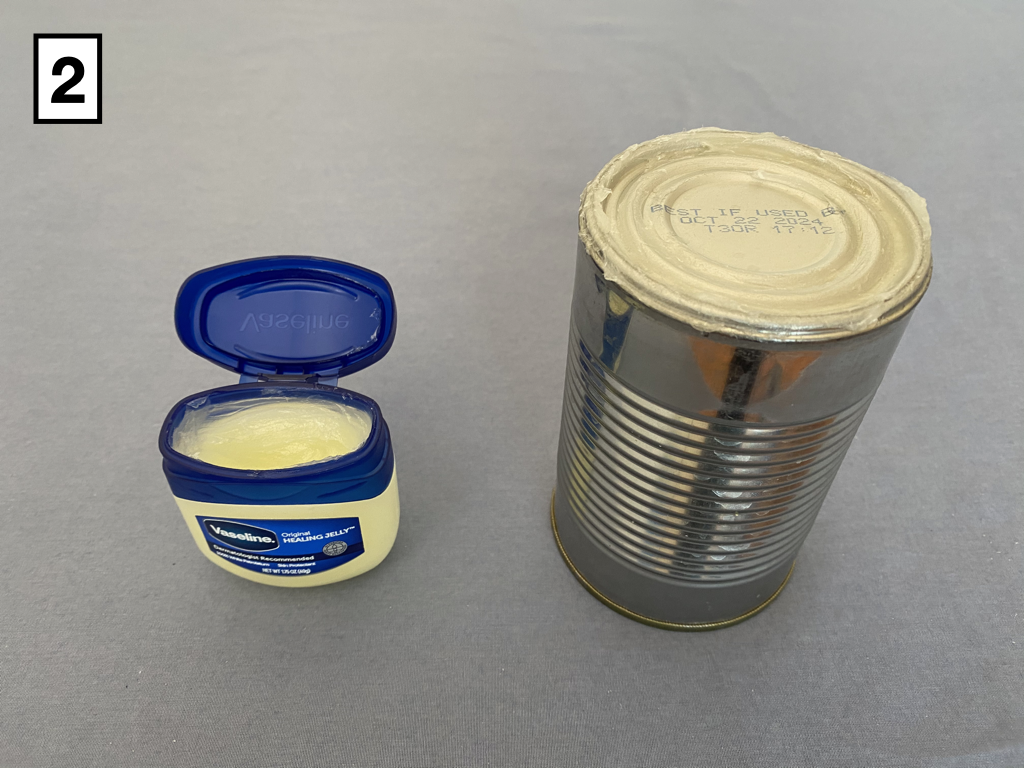
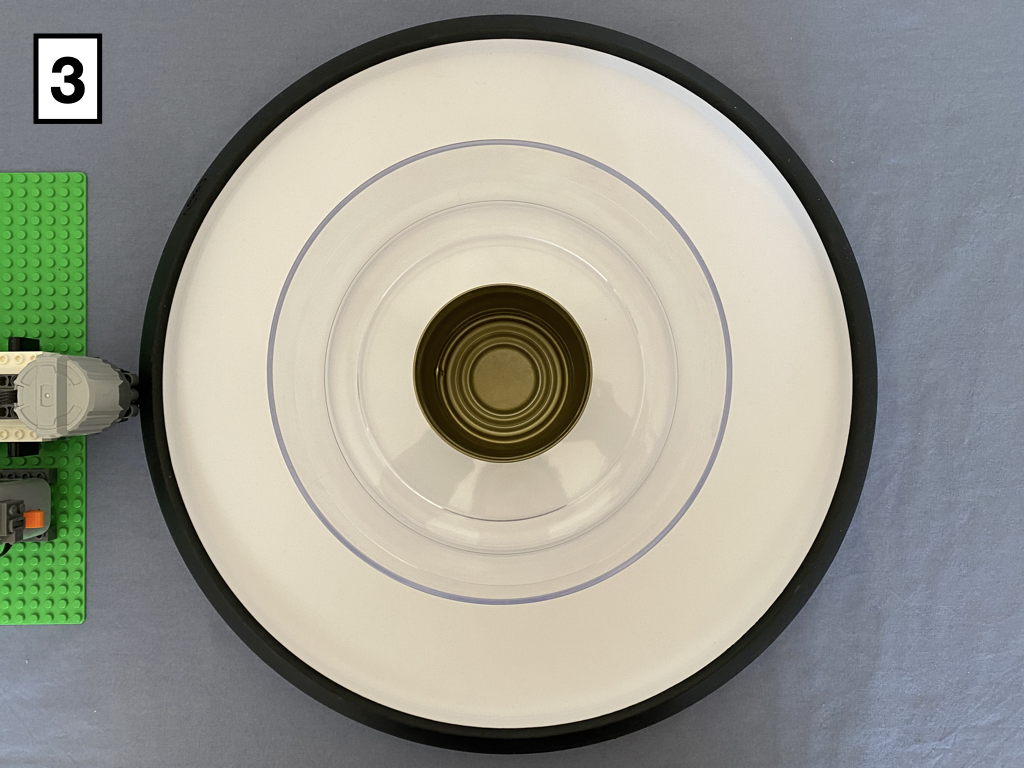
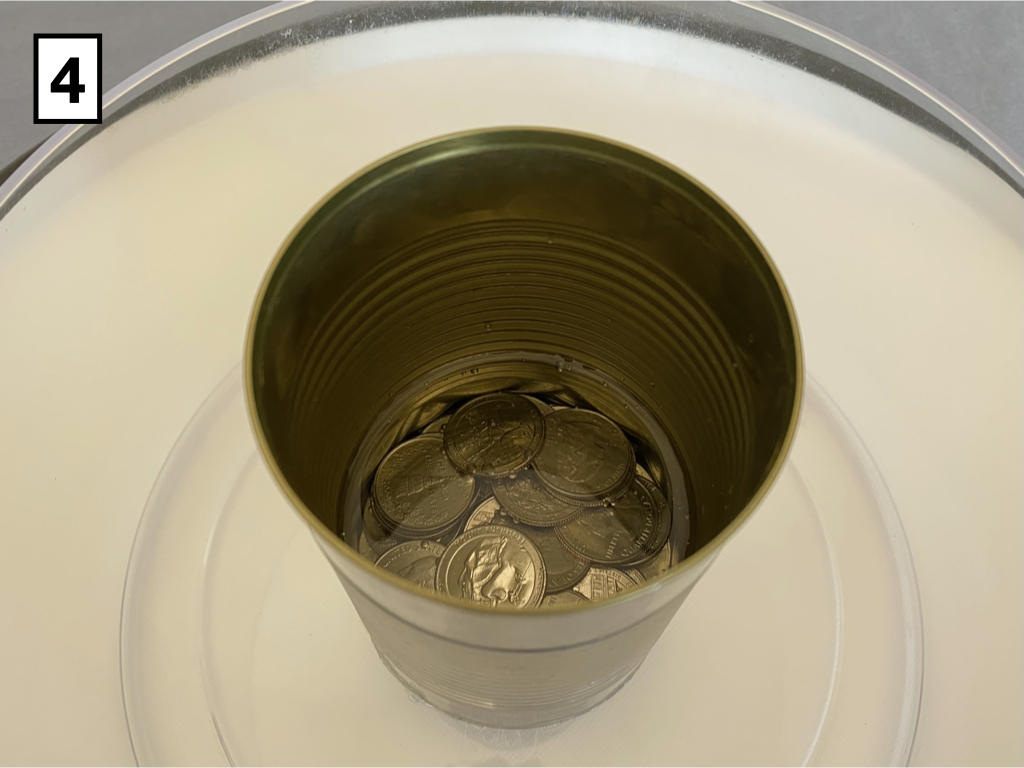

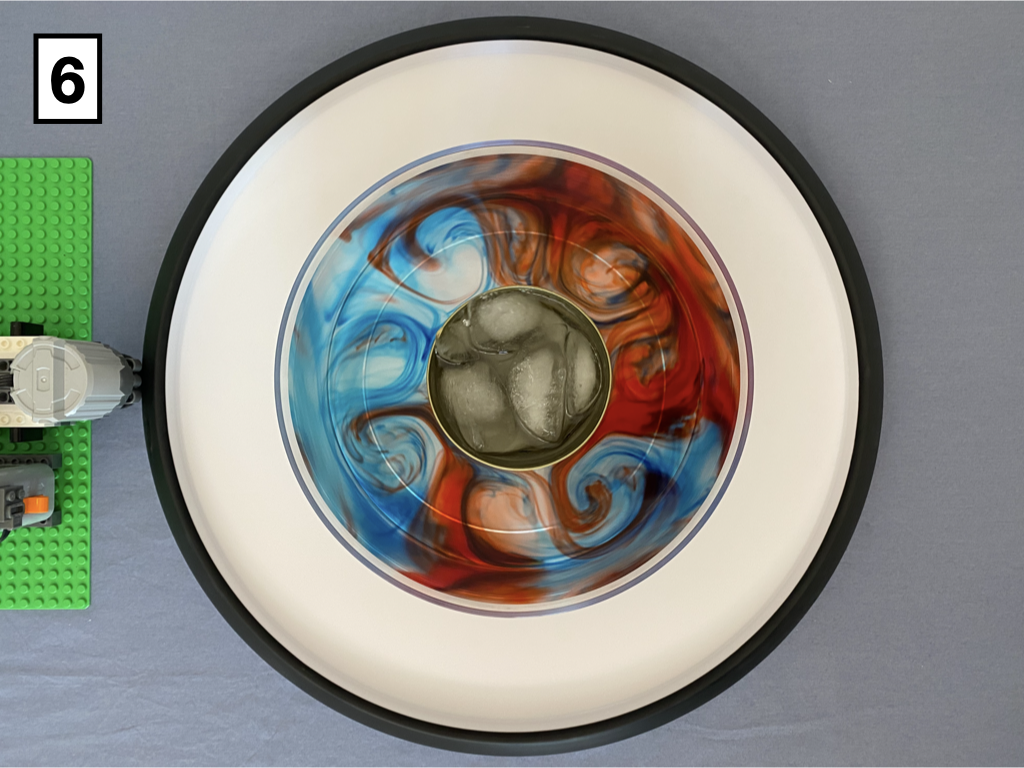
Step 1: Gather materials — empty can with lid removed, vaseline, weights (e.g. coins) and ice. Step 2: Apply vaseline to the bottom of the can. The vaseline will create a temporary seal between the can and the tank. Step 3: Push vaseline end down to fix the can to the center of the tank. Step 4: Add the weights to the can and fill the can approximately one third full with water. The weights serve to prevent the can from floating once water is added to the tank. The water serves to help the ice added later couple with its surroundings for transfer of heat. Step 5: Add water to the tank and begin spin up. Once the system is in a state of solid body rotation, fill the can with ice. Step 6: Proceed with your experiment!
Recommended Parts - Vaseline - Ice Cube Tray
Filming an Experiment
The DIYnamics Kits facilitate demonstrations that help provide an intuition into the forces behind our weather, ocean currents, magnetic field and more! A key aspect of effective learning is observing the links between structures in the model and in the real world. Filming experiments is a helpful step in teaching with the DIYnamics Kits. Movies can capture the fluid dynamics of a system for later analysis. Points to consider include:
Choosing Equipment

Smartphones are convenient and effective for capturing footage of experiments! Your filming setup will depend on your objectives but more often than not, required equipment can either be found in your household or purchased affordably. The gooseneck camera clamp (pictured supporting the smartphone above the tank) is very useful — its flexibility enables framing the right shot whilst staying out of way of experiments.
All you need to start filming is your smartphone! Action cameras like GoPros pack significant capabilities in a small package whilst enthusiast cameras like DSLRs offer high quality. Nevertheless, the core functionality needed can be obtained with the device in your pocket. Choose the option best for you! The filming setup can most often be put together from household items or with affordable consumer grade gear. We recommend the gooseneck camera clamp for supporting your smartphone. Its long flexible arm enables tuning the smartphone’s position until the shot is framed just right. Meanwhile, its thin yet sturdy frame make it compact enough to stay out of the way of experiments. Note that each DIYnamics Kits features an option for mounting a camera in the system. Other equipment to consider includes lighting. The choice depends on the filming environment and experimental requirements but the general goal is to illuminate the scene whilst avoiding common pitfalls described below. The choice of equipment is overall flexible — adapt to your demonstration with materials at hand.
Recommended Parts - Gooseneck Camera Clamp
Framing a Shot
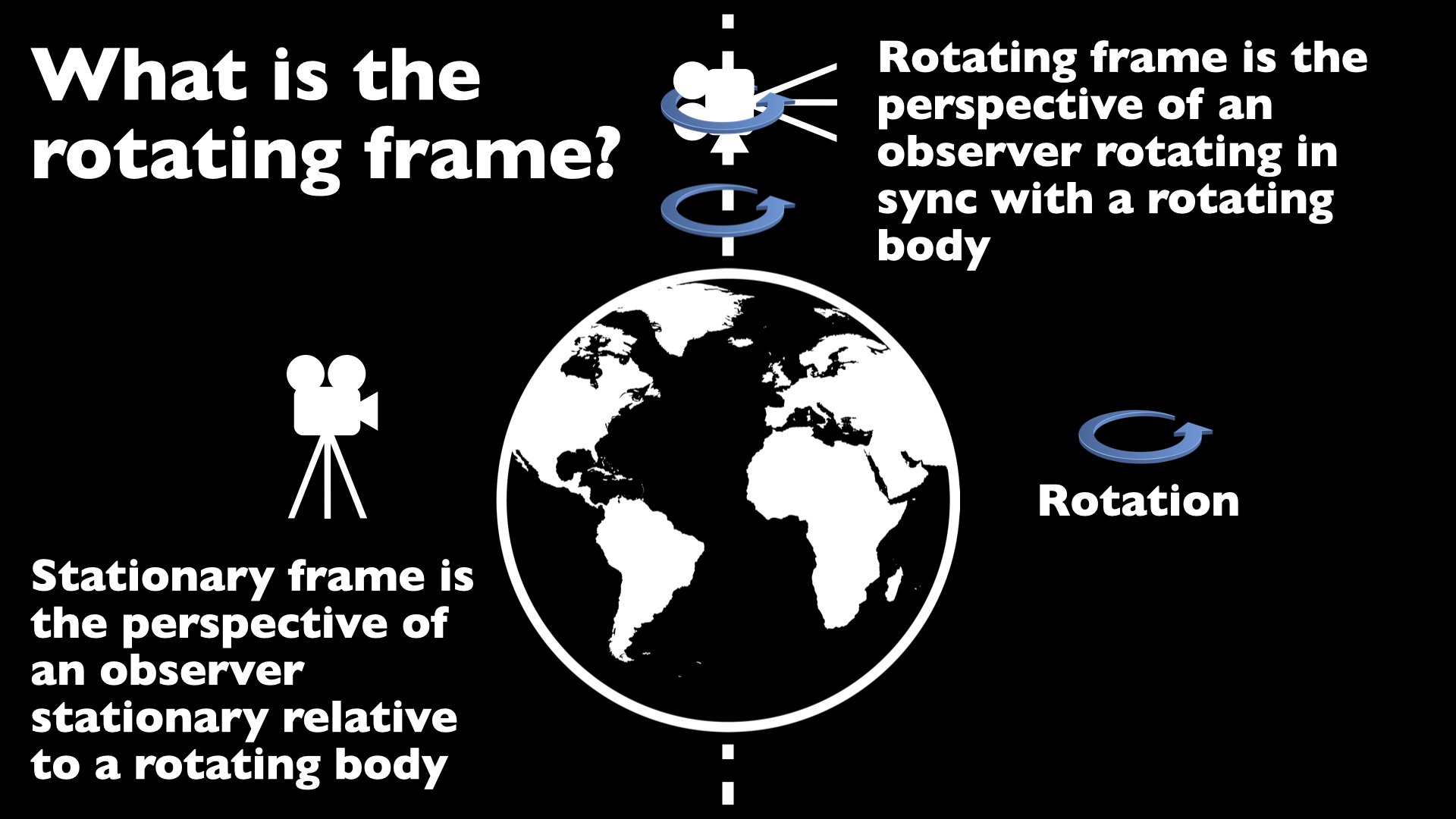
Rotating versus stationary frame. The rotating frame is analogous to a person observing a planet from its poles — the person is inside the system and rotating in sync. The stationary frame is analogous to a spacecraft observing a planet from afar — the spacecraft is outside of the system and fixed.


Framing a (L) top down versus (R) side shot in the rotating frame. The choice of perspective depends on experiment. A top down shot captures horizontal fluid motions across the fluid layer whilst a side shot captures vertical fluid motions through the fluid layer.
Different experiments are best captured in different perspectives. A key distinction in framing a shot is the rotating versus stationary frames. The rotating frame refers to the view of a camera rotating in sync with the system. The stationary frame refers to the view of a camera fixed relative to the system. The rotating frame is generally preferable to the stationary frame because it abstracts away rotation thus yielding fluid motions, our subject of interest, themselves. However, there can be utility in filming in the stationary frame.
Besides the rotating versus stationary frames, shots are distinguished by their angle towards the tank. Rotating tanks of water feature fluid motions aligned with the axis of rotation. When in a state of solid body rotation (described below), the fluid layer acts as if it were 2D. Thus, for many experiments, we are interested in framing a top down shot of the tank — this highlights horizontal fluid motions across the fluid layer (e.g. baroclinc eddies formed by a horizontal temperature gradient). Nevertheless, for other experiments, we are interested in framing a side shot of the tank — this highlights vertical fluid motions through the fluid layer (e.g. thermal wind shear formed by a vertical density difference).
Choices in framing a shot depend on your experiment — each will necessitate a different filming setup. It provides an interesting opportunity to apply your creativity with DIY solutions!
Setting Up Lighting
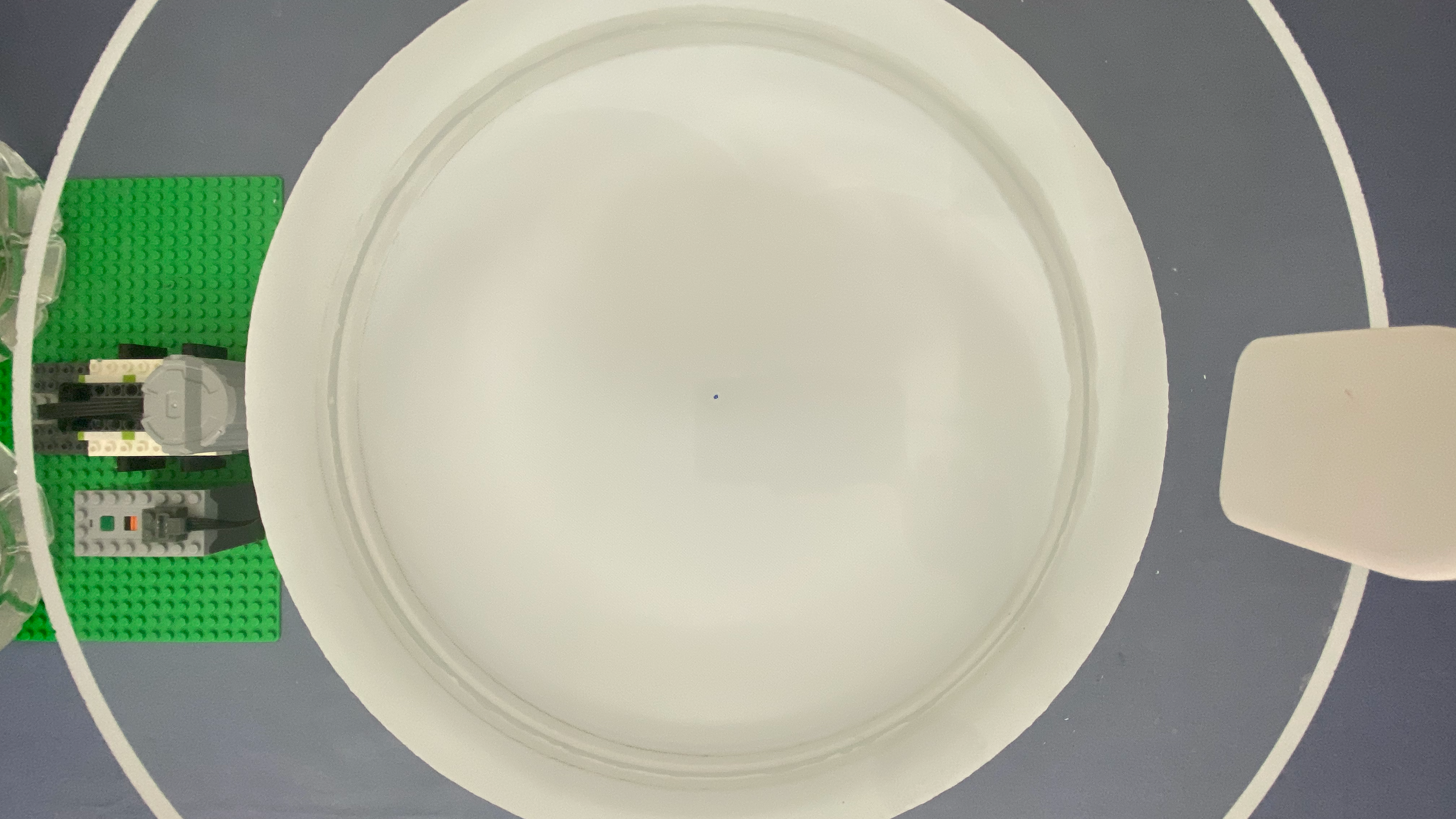

Surface of fluid layer without (L) and with (R) reflections from lights in the stationary frame. Reflections yield distracting artifacts because cameras in the rotating frame perceive lights in the stationary frame as objects circling around the tank. Thus, no reflections are ideal.
The goal of setting up lighting is to consistently illuminate the fluid layer in the shot. Lights are fixed whilst the tank rotates. Thus, when capturing footage in the rotating frame, any reflections or shadows from the stationary frame will circle around the tank. The distracting artifacts can be avoided by applying even brightness to ensure that the lighting appears the same at each position throughout rotation.
There are a multitude of approaches to consistently illuminate the fluid layer — finding the optimal approach will require trial and error. One option is to light the room with floor lamps placed away from the tank. The floor lamps create ambient lighting that brightens the fluid layer yet does not directly shine on its surface — this is achieved with diffusers that scatter light and placement far enough to avoid reflections. The majority of results on this page are filmed with this approach — specific equipment consists of IKEA floor lamps with Feit LED light bulbs. Another option is to make the entire room dark and mount battery powered lights in the rotating frame. The lights, camera and tank all rotate in sync thus ensuring uniform lighting for the entire cycle.
Livestreaming Footage
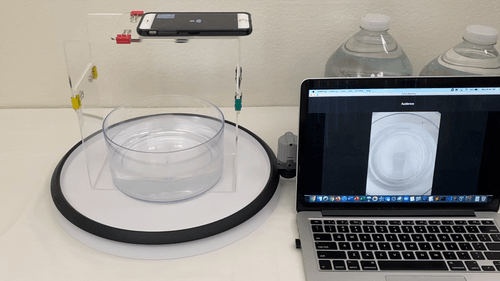
Livestreaming footage (Zoom method pictured above) enables audience members to make observations from key vantage points in real-time. There is significant utility in real-time observations because structures in the model, as with their real world counterparts, are constantly evolving. Teachers and students can work together to analyze and predict the system’s state.
A highlight of the DIYnamics Kits is that audience members can play an active role in experiments. The visual analogs between the model and the real world inspire a healthy back and forth between teachers and students that help drive demonstrations. Filming an experiment traditionally involves recording a movie then performing analysis afterwards. However, during experiments, learning opportunities arise when participants manipulate the system and track the cause and effect. Thus, it is ideal to observe fluid motions in the tank as they occur. Cameras such as GoPros feature functionality to livestream footage. This can be achieved in smartphones for free using Zoom!
Guide to Setting Up Zoom Livestreaming PDF
Obtaining Rotating Frame Results


(L) Rotating versus stationary frame. The rotating frame is analogous to a person observing a planet from its poles — the person is inside the system and rotating in sync. The stationary frame is analogous to a spacecraft observing a planet from afar — the spacecraft is outside of the system and fixed. (R) Rotating frame results for baroclinic instability. The perspective enables observing fluid motions sans rotation! It is the go-to option for analysis.
When the tank on any of the DIYnamics Kits is rapidly rotating, it can be hard to see the more subtle behaviors occurring inside. To get around this, it is really helpful to assume the view of an observer looking at the tank from above and spinning in sync — what we call the rotating frame. There are two options for obtaining rotating frame results:
Option 1: Capture Rotating Frame Footage


Rotating frame filming setup (L) and footage (R). Capturing footage in the rotating frame allows us to view fluid motions with rotating abstracted away — rotating frame results. The footage is of highest quality because no post-processing is required. However, the filming setup poses design challenges as the camera is supported by a point within yet must not disrupt the system. Note that Ω indicates the rotation direction.
Placing a camera in the rotating frame allows us to directly obtain rotating frame results. A benefit of this approach is that natively capturing rotating frame footage yields crisp movies. A challenge of this approach is that the filming setup is subject to constraints. The mount must be compact and light enough to fit within the rotating system yet sturdy enough to support a camera. Note that we have designed solutions for each DIYnamics Kit to place a camera in the rotating frame.
Option 2: Capturing then De-Rotating Stationary Frame Footage
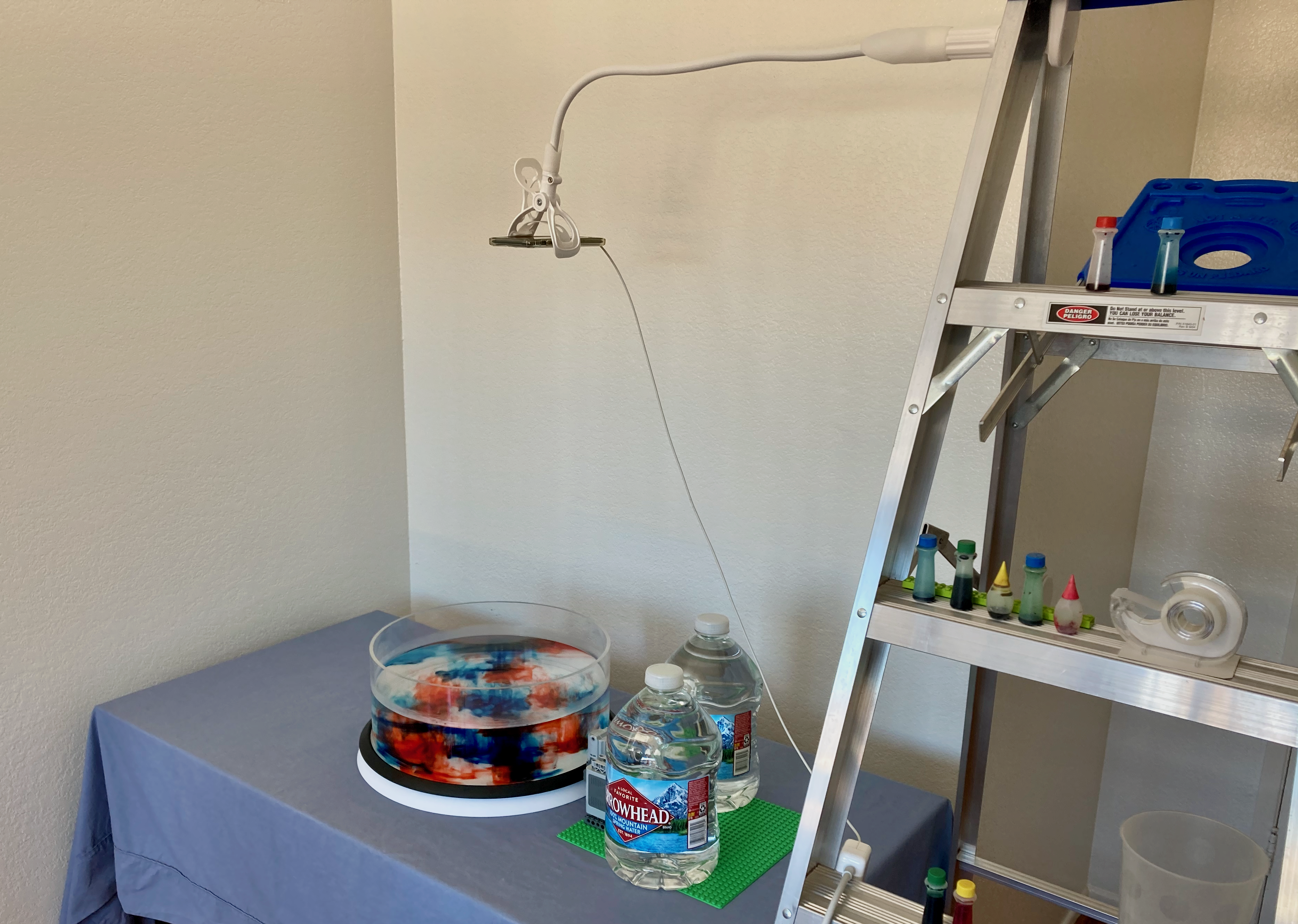
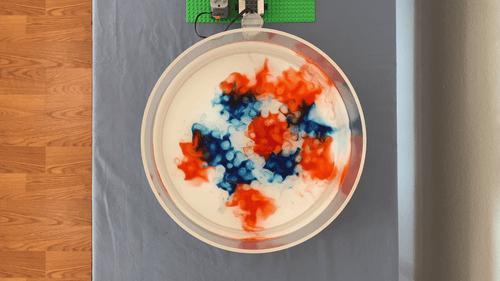
Stationary frame filming setup (L) and footage (R). Capturing footage in the stationary frame yields movies featuring both fluid motions and rotation. The footage is difficult to interpret because fluid motions visually mix with rotation and are difficult to separate mentally. However, the filming setup is straightforward as the camera can be suspended above the tank with few limitations.

DIYrotate footage. The web app enables de-rotating, or rotating contrary to the system’s rotation, stationary frame footage. This process cancels out the system’s rotation thus yielding fluid motions themselves — rotating frame results. The footage is easy to interpret and approaches the quality of natively captured rotating frame footage. Meanwhile, the filming setup for capturing stationary frame footage is straightforward. After recording, the only post-processing steps consist of uploading stationary frame footage and providing de-rotation parameters to DIYrotate.
Placing a camera in the stationary frame then applying DIYrotate provides the “best of both worlds” for obtaining rotating frame results. Capturing stationary frame footage is a simpler process than its counterpart because the camera remains fixed rather than rotating. However, the movies feature both fluid motions and rotation thus compromising interpretability. To this end, we developed DIYrotate to digitally rotate movies. The web app can be applied to de-rotate or cancel out the system’s rotation in stationary frame footage thus leaving fluid motions behind. DIYrotate provides a convenient compromise — stationary frame footage is easier to capture whilst de-rotated footage approaches the superior quality of native rotating frame footage.
